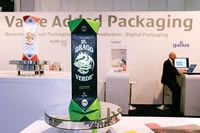This latest feather in Kamboo’s cap fits neatly with existing agencies such as products from the Ferag stable, specialising in inserting, conveying and bundling lines that streamline postpress and mailroom operations for newspaper and magazine printers; the Fife line of sophisticated web-guiding and inspection systems; QuadTech’s printing and colour control systems; Toray flexible printing plates; and Klöckner Pentaplast’s advanced shrink sleeve materials.
As Hannes remarks, ‘We sell our products to similar customer categories in the printing and packaging sectors, and we’re delighted to add Planatol to our portfolio.’
Planamelt – easily applied
Planatol has recently expanded its portfolio in the graphic arts industry with the development of a hotmelt adhesive called Planamelt, based on innovative ingredients that solve common problems and reduces process costs.
Practical tests at the University of Applied Sciences in Munich, as well as field tests with machinery manufacturers and printers, have shown that Planamelt offers considerably higher cohesiveness than ordinary EVA hotmelts – in some cases results are even as good as a PUR system.
Asked whether this adhesive is suitable for both book and magazine binding operations, Hannes confirms that both are target markets.
‘Planamelt adhesives are suitable for nozzle and roller applications,’ he replies. ‘They’re simple to apply, and can be processed on standard, unmodified hotmelt equipment at low temperature.’
Other notable plus points include low processing odour; constant viscosity; stability under high thermal load (such as multiple heating); and high resistance to thermal distortion. Especially in digital printing, Planamelt achieves excellent results owing to its high oil resistance.
Perfect for thick and varying paper grades
Adhesion to difficult surfaces and good layflat characteristics are other remarkable features. Planamelt provides perfect adhesion for heavy grades of paper up to 250g/m².
Tests carried out in conjunction with a number of OEMs confirm pull resistance values of 13N/cm for printed paper with a grammage of 170g/m². This means that Planamelt, selling at a comparable price to EVA, achieves higher pull resistance than EVA while using significantly less adhesive.
This places process costs at the same level as conventional EVA but half that of PUR adhesives. Maintenance costs are also reduced.
Robert Alber, MD of Planatol Adhesive, is proud of this innovation: ‘Planamelt is spectacular in its characteristics and proves our contention that cost awareness and high quality are not contradictory,’ he comments. ‘Thanks to intense research over a number of years, we’ve succeeded in producing an adhesive that combines the performance benefits of a PUR with the application benefits of a typical EVA hotmelt.’










